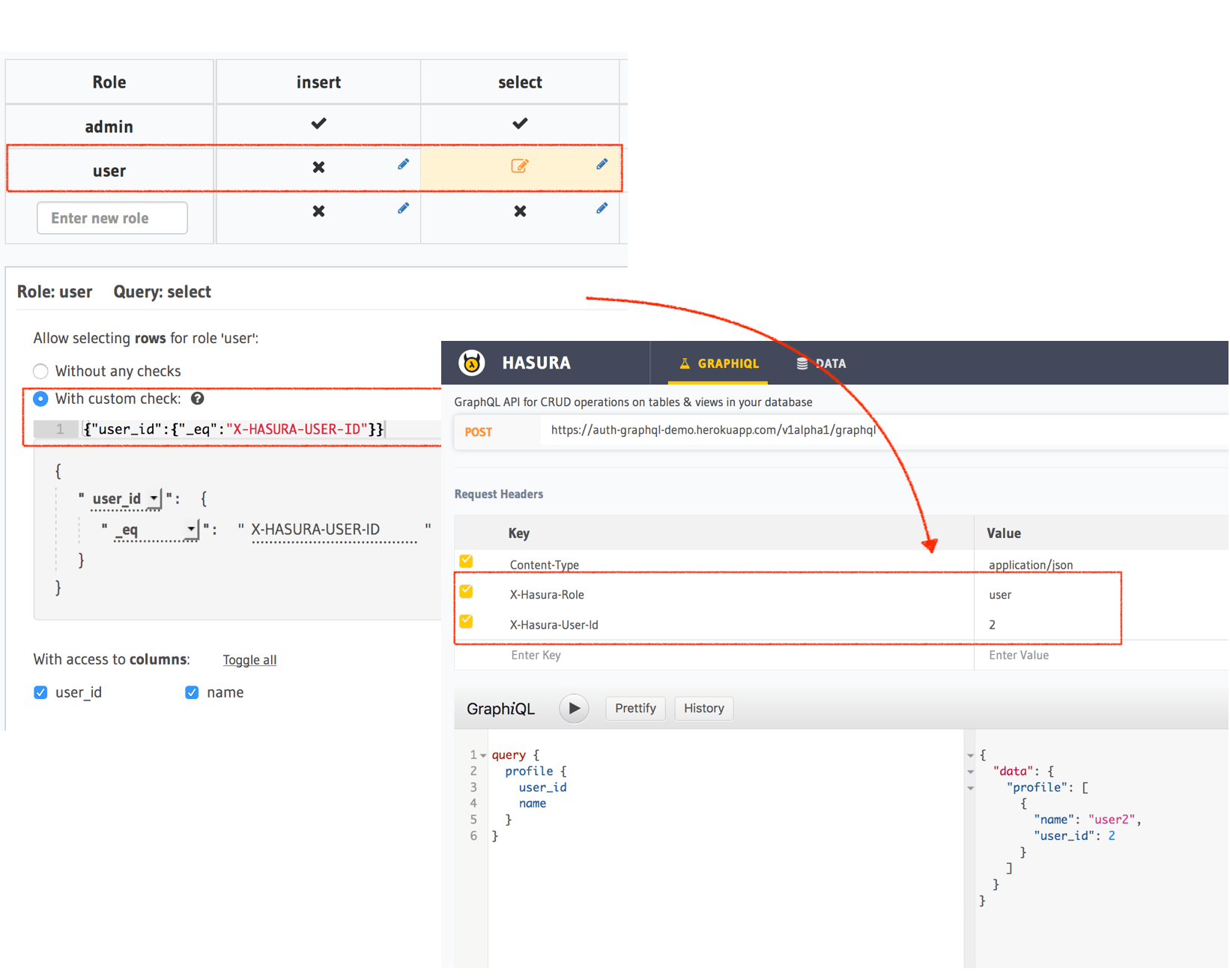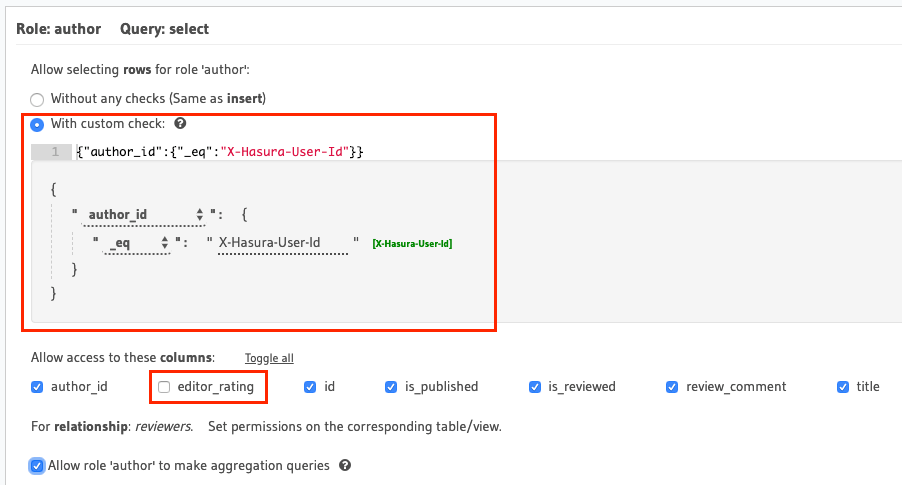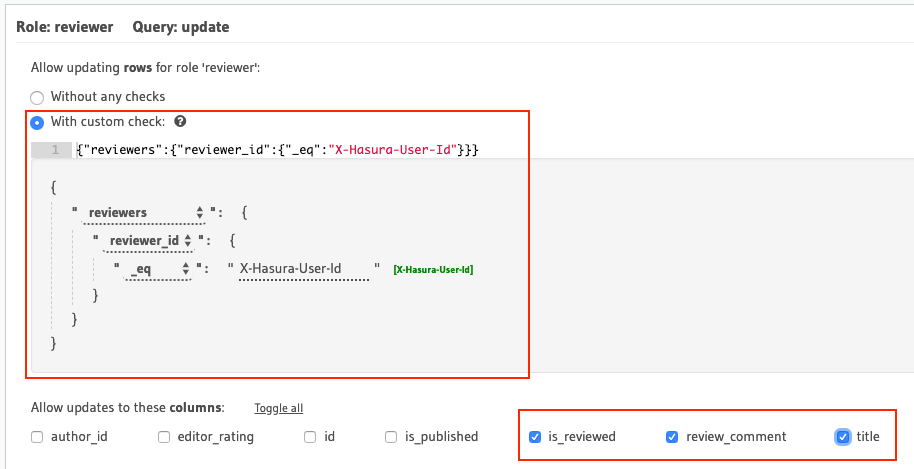- Hasura GraphQL Engine
Access control examples¶
Table of contents
Introduction¶
This is a guide to help you set up a basic authorization architecture for your GraphQL fields. It is recommended that you first check out Roles & Session variables and Configuring permission rules that will be referred to throughout this guide.
Here are some examples of common use cases.
Anonymous (not logged in) users¶
- Create a role called
anonymous(this value is up to you, you could even name the rolepublic). - Generally, you wouldn’t add insert, update, or delete permissions.
- For the select permission condition, create a valid condition depending on your data model. For example,
is_published: {_eq: true}. - If you don’t have a condition, then just set the permission to
Without any checks, represented by a{}. - Choose the right set of columns that will get exposed in the GraphQL schema as fields. Ensure that sensitive information will not be exposed.

See Unauthenticated / Public access for steps to configure the anonymous user role in Hasura.
Logged-in users¶
- Create a role called
user. - Access control rules in this case are usually dependent on a
user_idor aowner_idcolumn in your data model. - Set up a permission for insert/select/update/delete that uses said column. E.g.:
author_id: {_eq: "X-Hasura-User-Id"}for an article table. - Note that the
X-Hasura-User-Idis a dynamic session variable that comes in from your auth webhook’s response, or as a request header if you’re testing.

Managers of an organisation in a multi-tenant app¶
Suppose you have a multi-tenant application where managers of a particular organisation can see all of the data that
belongs to the organisation. In this case, your data models will probably have an org_id column that denotes the
organisation either in the same table or via a related table.
- Create a role called
manager. - Create a permission for select, which has the condition:
org_id: {_eq: "X-Hasura-Org-Id"}. X-Hasura-Org-Idis a dynamic variable that is returned by your auth webhook for an incoming GraphQL request.

Collaborators of an article¶
Let’s say the “ownership” or “visibility” information for a data model (table) is not present as a column in the table, but in a different related table. In this case, let’s say there is an article table and a collaborator table that has article_id, collaborator_id columns.
- Create a relationship called
collaboratorsfrom the article table.- Array relationship (article has array of collaborators):
article :: id → collaborator :: article_id.
- Array relationship (article has array of collaborators):
- Create a role called
collaborator. - Create a select permission on the
articletable, which has the condition:collaborators: {collaborator_id: {_eq: "X-Hasura-User_id"}}.- This reads as: Allow the role collaborator to select if
article.collaboratorshas acollaborator_idequal to that ofX-Hasura-User-Id.
- This reads as: Allow the role collaborator to select if

Multiple roles per user¶
Sometimes your data/user model requires that:
- Users can have multiple roles.
- Each role has access to different parts of your database schema.
If you have the information about roles and how they map to your data in the same database as the one configured with the GraphQL engine, you can leverage relationships to define permissions that effectively control access to data and the operations each role is allowed to perform.
To understand how this works, let’s model the roles and corresponding permissions in the context of a blog app with the following roles:
author: Users with this role can submit their own articles.reviewer: Users with this role can review articles assigned to them and add a review comment to each article. A mapping of articles to reviewers is maintained in thereviewerstable.editor: Users with this role can edit and publish any article. They can also leave a private rating for each article. However, they cannot overwrite a reviewer’s notes. A list of editors is maintained in theeditorstable.
Database Schema¶
The following is a reference database schema for our example:

Based on the above schema, we’ll create the following tables:
-- user information from your auth system
users (
id INT PRIMARY KEY,
name TEXT,
profile JSONB, -- some profile information like display_name, etc.
registered_at TIMESTAMP -- the time when this user registered
)
-- information about articles
articles (
id INTEGER PRIMARY KEY,
title TEXT,
author_id INT REFERENCES users(id), -- Foreign key to users :: id
is_reviewed BOOLEAN DEFAULT FALSE,
review_comment TEXT,
is_published BOOLEAN DEFAULT FALSE,
editor_rating INTEGER
)
-- mapping of reviewers to articles
reviewers (
id INTEGER PRIMARY KEY,
article_id INTEGER REFERENCES articles(id), -- Foreign key to articles :: id
reviewer_id INTEGER REFERENCES users(id) -- Foreign key to users :: id
)
-- a list of editors
editors (
editor_id INTEGER PRIMARY KEY REFERENCES users(id) -- Foreign key to users :: id
)
Relationships¶
Create an array relationship named reviewers based on the foreign key constraint reviewers :: article_id → articles :: id:

Permissions¶
The following is an example summary of the access control requirements for the articles table based on the above schema:
Columns of
the article
table |
author | reviewer | editor | |||
|---|---|---|---|---|---|---|
| insert | select | update | select | update | select | |
| id | ✔ | ✔ | ✖ | ✔ | ✖ | ✔ |
| title | ✔ | ✔ | ✔ | ✔ | ✔ | ✔ |
| author_id | ✔ * | ✔ | ✖ | ✔ | ✖ | ✔ |
| is_reviewed | ✖ | ✔ | ✔ | ✔ | ✔ | ✔ |
| review_comment | ✖ | ✔ | ✔ | ✔ | ✖ | ✔ |
| is_published | ✖ | ✔ | ✖ | ✔ | ✔ | ✔ |
| editor_rating | ✖ | ✖ | ✖ | ✖ | ✔ | ✔ |
* Additional restriction required to ensure that a user with the role author can submit only their own article i.e. author_id should be the same as the user’s id.
We’ll create permission rules for the roles and actions listed above (you can easily extend them for the actions not documented here) .
Permissions for role author¶
Allow users with the role
authorto insert only their own articlesFor this permission rule, we’ll make use of two features of the GraphQL engine’s permissions system:
- Column-level permissions: Restrict access to certain columns only.
- Column presets: Session-variable-based column preset for the
author_idcolumn to automatically insert the user’s ID i.e. theX-Hasura-User-Idsession-variable’s value. It also helps us avoid explicitly passing the user’s ID in the insert mutation.

Notice how we don’t need to have an explicit row-level permission (a custom check) as only authenticated users with the role
authorcan perform this action. As we have a column preset for theauthor_idcolumn that automatically takes the author’s ID (and theidcolumn is an auto-increment integer field), we only need to allow access to thetitlecolumn.Allow users with the role
authorto select certain columns onlyAgain, we’ll use column-level permissions to restrict access to certain columns. Additionally, we need to define row-level permissions (a custom check) to restrict access to only those articles authored by the current user:

The row-level permission rule shown here translates to “if the value in the
author_idcolumn of this row is equal to the user’s ID i.e. theX-Hasura-User-Idsession-variable’s value, allow access to it”.
Permissions for role reviewer¶
Allow users with the role
reviewerto update articles assigned to them for reviewsFor this use-case, we’ll use relationship or nested-object permissions based on the array relationship
reviewersto restrict access to assigned articles only.
The array-relationship based permission rule in the above image reads as “if the ID of any reviewer assigned to this article is equal to the user’s ID i.e. the
X-Hasura-User-Idsession-variable’s value, allow access to it”. The columns’ access is restricted using the column-level permissions highlighted above.Allow users with the role
reviewerto select articles assigned to them for reviewsThis permission rule is pretty much the same as the one for update, the only difference being the column-level permissions.

Permissions for role editor¶
Allow editors to select any article’s data
This is a straightforward rule - there’s no need for any row-level permissions since editors have access to all rows and they can read all columns.

Allow editors to update an article
There’s no need for row-level permissions in this case either but we need to restrict access to certain columns only:

